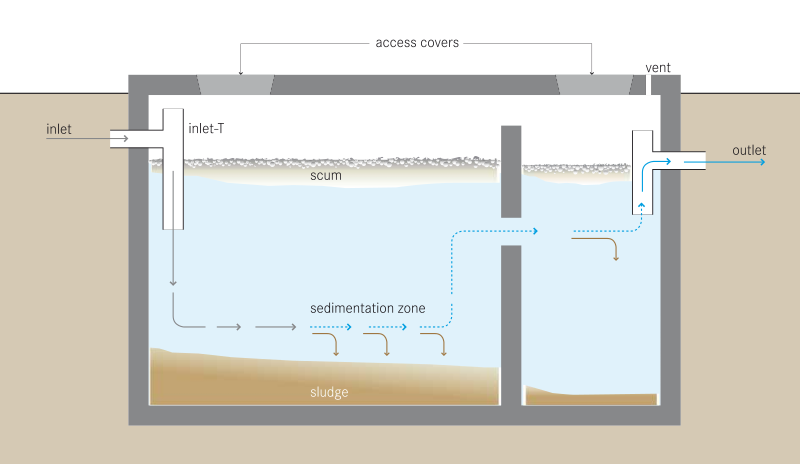How Does a Septic Tank Work?
Most of us know that septic tanks exist. However, if you’re like most Americans, you may ask yourself, “How does a septic tank work?” if you really think about it. That’s okay – unless you live in a rural area, simply flushing the toilet is all you may have to do with wastewater treatment. But, if you live in a rural area or may ever move to one, you should learn how a septic system works, how to take care of it, and what the signs of septic system failures are.
 Where are Septic Systems?
Where are Septic Systems?
If you live in a city or a suburban area, there’s a good chance that you have a sewer system. In other locations, like rural spaces, it’s too expensive to build a connecting system like that. Instead, everyone has their own self-sufficient septic tank to take care of waste from the house. If you live in an area where the houses are separated and not close to an urban area, you may have a septic system! The entire septic system consists of the pipe from the house, the large septic tank, and then a drain field (also called a leach field). A septic tank is a large metal or concrete tank that can hold as much as 1,000 gallons of water. The drain field is where the effluent from the tank goes. Don’t have the whole idea yet? Don’t worry, we’re going through step by step, too.
How Does a Septic Tank Work?
 First, all the wastewater in the house flows into a main drainage pipe. The water enters the tank, which is located underground near the house. Inside the tank, organic material in the wastewater separates over time with the help of bacteria in the water. The solid waste sinks to the bottom of the tank, forming sludge, while the oils and grease from the wastewater form scum on the top of the water in the tank. The sludge and scum stay in the tank, and the effluent (liquid wastewater) flows out of the other side of the tank and towards the drain field. This effluent is cleaner and free of solids when it flows out of the tank.
First, all the wastewater in the house flows into a main drainage pipe. The water enters the tank, which is located underground near the house. Inside the tank, organic material in the wastewater separates over time with the help of bacteria in the water. The solid waste sinks to the bottom of the tank, forming sludge, while the oils and grease from the wastewater form scum on the top of the water in the tank. The sludge and scum stay in the tank, and the effluent (liquid wastewater) flows out of the other side of the tank and towards the drain field. This effluent is cleaner and free of solids when it flows out of the tank.
How does the sludge and scum stay inside the tank instead of leaving the tank? There are t-shaped pipes that prevent material at the top and bottom of the tank from flowing out. The water is passively pushed out of the tank as new water flows into it. When the effluent is pushed out of the tank, it enters several perforated pipes deep underground. This is the drain field, an area in the ground surrounded by gravel to allow the effluent to seep into the ground and disperse. The drain field can be really big or pretty small. It depends on how much water the ground can hold. Compact or saturated soil will need a big area, while dry and loose soil will need a much smaller area for the effluent. What happens after the effluent leaves the field pipe? Bacteria naturally decompose any remaining waste in the water and act as fertilizer. That’s why the grass near the septic tank is always greener!
Finding Your Septic System
There are a few ways to find your septic system. Often, you can find a manhole cover or lid in the yard above the septic tank. This is the maintenance cover that can be removed for professionals to pump the tank. They are pretty big, round, flat covers that are hard to miss. If you’ve ever found one in your yard, you probably have a septic system! Another trick to finding the septic system is finding the drain field. Like we said, the grass is always greener above the drain field because the bacteria and organic material from the leach field serves as nutritious fertilizer! It will be a much greener section of grass, so it’ll also be hard to miss.
Environmental Health Concerns
 Septic systems have been used for years and years in place of sewer systems. While you may think, “Gross! That waste is draining into the ground? That can’t be healthy!”, that’s not entirely true. The septic system work to keep most of the disgusting stuff out of the ground and in the tank. Whatever comes out in the liquid wastewater is usually safe for the environment and just acts as fertilizer. However, this changes when owners don’t maintain their systems. In Brevard County, it’s a big deal because we have the lagoon, ocean, and river. If septic system owners don’t take care of their systems, our ecosystem can be seriously affected. So, especially in our beautiful county, it’s crucial to properly care for our septic tanks!
Septic systems have been used for years and years in place of sewer systems. While you may think, “Gross! That waste is draining into the ground? That can’t be healthy!”, that’s not entirely true. The septic system work to keep most of the disgusting stuff out of the ground and in the tank. Whatever comes out in the liquid wastewater is usually safe for the environment and just acts as fertilizer. However, this changes when owners don’t maintain their systems. In Brevard County, it’s a big deal because we have the lagoon, ocean, and river. If septic system owners don’t take care of their systems, our ecosystem can be seriously affected. So, especially in our beautiful county, it’s crucial to properly care for our septic tanks!
So how can someone take care of their septic tank?
Caring for Your Septic System
 There are a couple things to look out for when you’re worried about a failing septic system. One major sign of a septic system having problems is the occurrence of sewage in drains and backed-up toilets. There also shouldn’t be any extra surface water or a bad smell around the area of the septic tank – if there is, you need to call someone out! Sometimes the solution is simple: the signs are telling you that the tank should be pumped.
There are a couple things to look out for when you’re worried about a failing septic system. One major sign of a septic system having problems is the occurrence of sewage in drains and backed-up toilets. There also shouldn’t be any extra surface water or a bad smell around the area of the septic tank – if there is, you need to call someone out! Sometimes the solution is simple: the signs are telling you that the tank should be pumped.
However, the symptoms can be much worse than a routine pumping will fix. A septic tank can last months in a downswing without many symptoms of failure, and if you haven’t been taking care of the septic tank, it can cost thousands to fix or replace. So, take a look at our guide for maintaining your septic tank and make sure you get the most out of your tank! When properly maintained, a good tank can last 30 years.
There are also some tips to make your septic system last longer, tips that you can follow day to day. One, don’t overuse cleaners, bleach, or bio-damaging chemicals. The septic system runs off the good health of the bacteria in the tank, so it’s important not to overuse chemicals that can harm the ecosystem in the tank. Two, don’t put anything that doesn’t decompose down the drain – or doesn’t break down fast. Since the septic system is set up to break down organic materials, like food waste and body waste, inorganic material is bad for the system and can back up the system. And three, don’t park a vehicle or large object on top of the septic tank! It will damage the tank over time and cost more than a couple thousand dollars to replace.

No Comments